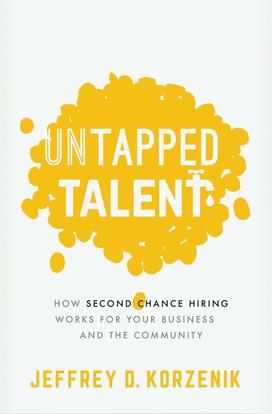The book: Untapped Talent (HarperCollins) explores the world of “second chance hiring” — the practice of hiring people who have criminal records. Employers should strongly consider recruiting from this untapped workforce, Korzenik writes, because they can help fill crucial business needs, especially during times of staffing shortages. Korzenik is honest about the strengths and weaknesses of the formerly imprisoned population — not every person with a record is ready for employment, and many may require individualized support. But by learning to embrace second chance hiring, he says, business leaders can gain a competitive advantage while empowering employees with criminal records to thrive in their new roles. Untapped Talent features real-life examples of second chance hiring, showing exactly how the practice can serve as a win-win scenario for employers and employees alike.

The author: Jeffrey Korzenik ’85 is a chief investment strategist at Fifth Third Bank, where he is responsible for the investment strategy and the allocation of over $40 billion in assets. A regular guest on CNBC, Fox Business News, and Bloomberg TV, his perspectives on the economy, markets, manufacturing, and the workforce are frequently cited in the financial and business press. He received an A.B. in economics and a certificate in Near Eastern studies from Princeton.
Excerpt:
The successful CEO of the future will be the one who can effectively manage through the coming talent shortage. That leader will understand the nature of this challenge, develop strategies to attract, develop, and retain a workforce, and inspire every level of company management to follow. This book will provide business leaders with an effective strategy for meeting this challenge.
Each economic cycle demands a different skill set that defines who will rise to the top in the business world. The successful CEOs of the 1970s navigated disruptive inflation and rising interest rates; the ability to control risk and exploit purchasing power drove success. The economist Thomas Mayer famously described the decade as the result of "the greatest failure of American macroeconomic policy in the postwar period.” The state of the nation was often measured by economist Arthur Okun's "misery index,” which is the sum of the unemployment rate and inflation. For businesses, this meant uncertain consumer and input costs that varied widely. Oil prices quadrupled over the decade, while iron and steel prices nearly tripled. Risk management tools and pricing models that we take for granted today were adopted by the leaders of this period.
Those skills mattered less in the 1980s. As the misery index fell, confidence returned and effective leaders switched from the defense of the preceding decade to offense—building better and better products and services. Those who prospered did so by implementing total quality management, flattening their company hierarchies, and driving results through vision and mission statements. Readers of a certain age will be familiar with Sam Walton’s famous ten rules for building a business, rules that epitomized much of the formula for success in the 1980s. Four of “Mr. Sam’s” rules revolve around breaking down the hierarchies that had dominated American management for a century. His view of employees as partners, focusing on their engagement, and his belief in sharing profits with workers, while considered common sense today, were pioneering in this period.
The 1990s brought forth new opportunities—and new management challenges—including broader and cheaper access to personal computer technology and the introduction of the internet for commercial use. The ability to lead through innovation defined the upper echelon of American business leadership as titans like Steve Jobs, Andy Grove, and Bill Gates became household names. Transformation was not found exclusively in the technology and telecom industries, as Jack Welch proved in his relentless focus on ensuring "upgrades" in his management ranks that were more powerful than many a software upgrade.
The history of our more recent decades is still being written, but some important characteristics of successful leadership have already been apparent. The 2000s required managers who could think internationally, whether through global sales or outsourcing to contain costs. The contribution of foreign earnings to the profits of the S&P 500 companies more than tripled in the years leading up to the Great Recession of 2007-2009. Even those who successfully navigated globalization might not have survived that financial crisis unless they also paid attention to strong balance sheets and access to credit.
The 2010 decade marked both the end and a new beginning of enormous significance, much of this relevant to the scope of this book. In a cycle with no major commercialized technological breakthroughs, extending the application of existing tools marked many business successes. For better or worse, crisis management and a Washington policy strategy became important additions to any leader’s toolbox.
But leaders in this cycle have been faced with truly new and interrelated challenges: I) the end of the period of rapid growth that had characterized the American economy since the end of World War II, 2) the (at least temporary) decline in productivity growth, and 3) the exit of baby boomers and entrance of millennials as the primary workers and significant consumers. Many of these factors are interrelated, but combined led to a severe labor and talent shortage.
As the 2010s came to a close, Labor Department statistics continued to show that job openings exceeded job-seekers. The National Federation of Independent Business (NFIB) surveys of small businesses cite the cost and availability of labor as the single biggest concern. Among larger companies, the CEOs and C-suite executives who participated in The Conference Board C-Suite Challenge 2019 survey identified their primary internal challenge: attracting and retaining top talent. Strikingly, this was true not only in the United States, but across all regions of the world. Although this concern will be interrupted by recessions, the long-term challenge will not change. Without workers, you can’t service your customers well. Without workers, you can’t grow your business. And if your competitors can get workers when you can’t, you lose.
It would be comforting to believe that this severe talent shortage is a mere cyclical concern, one that will dissipate with the next business cycle. It would be comforting to believe that this is a national problem that could be solved by global outsourcing. It would be comforting to believe that business leaders can ignore this challenge. But that would be wrong.
The pandemic of 2020 has elevated unemployment and freed workers, but even this has proven an incomplete solution for those companies that are still hiring. Yes, workers are available, but their skills and geography may not align with needs, retraining becomes less viable as workers age, and some workers are unavailable because of health concerns. To the degree that recessions create a surplus of available labor, it proves to be fleeting.
Reprinted from Untapped Talent, by Jeffrey Korzenik. Copyright © 2021 HarperCollins.
Review:
“Jeff Korzenik eloquently and convincingly makes the case that second chance hiring represents one of those rare 'win-win-win' situations in that it benefits the formerly incarcerated, employers and our society. Untapped Talent is a must-read book, not only for second chance advocates, but also for anyone who questions the benefits of giving returning citizens an opportunity to live their best lives.” — Johnny C. Taylor, President & CEO, Society for Human Resource Management











0 Responses